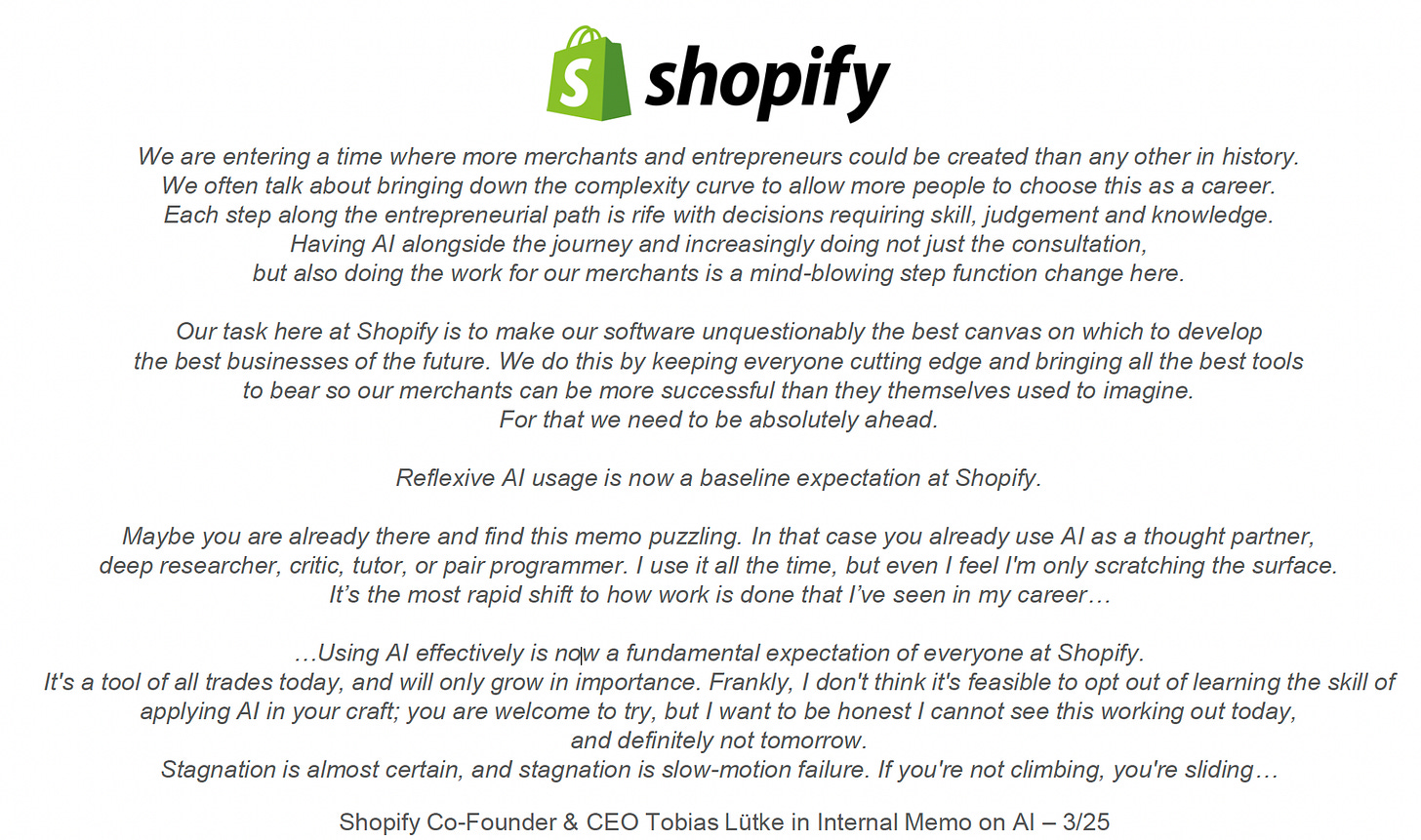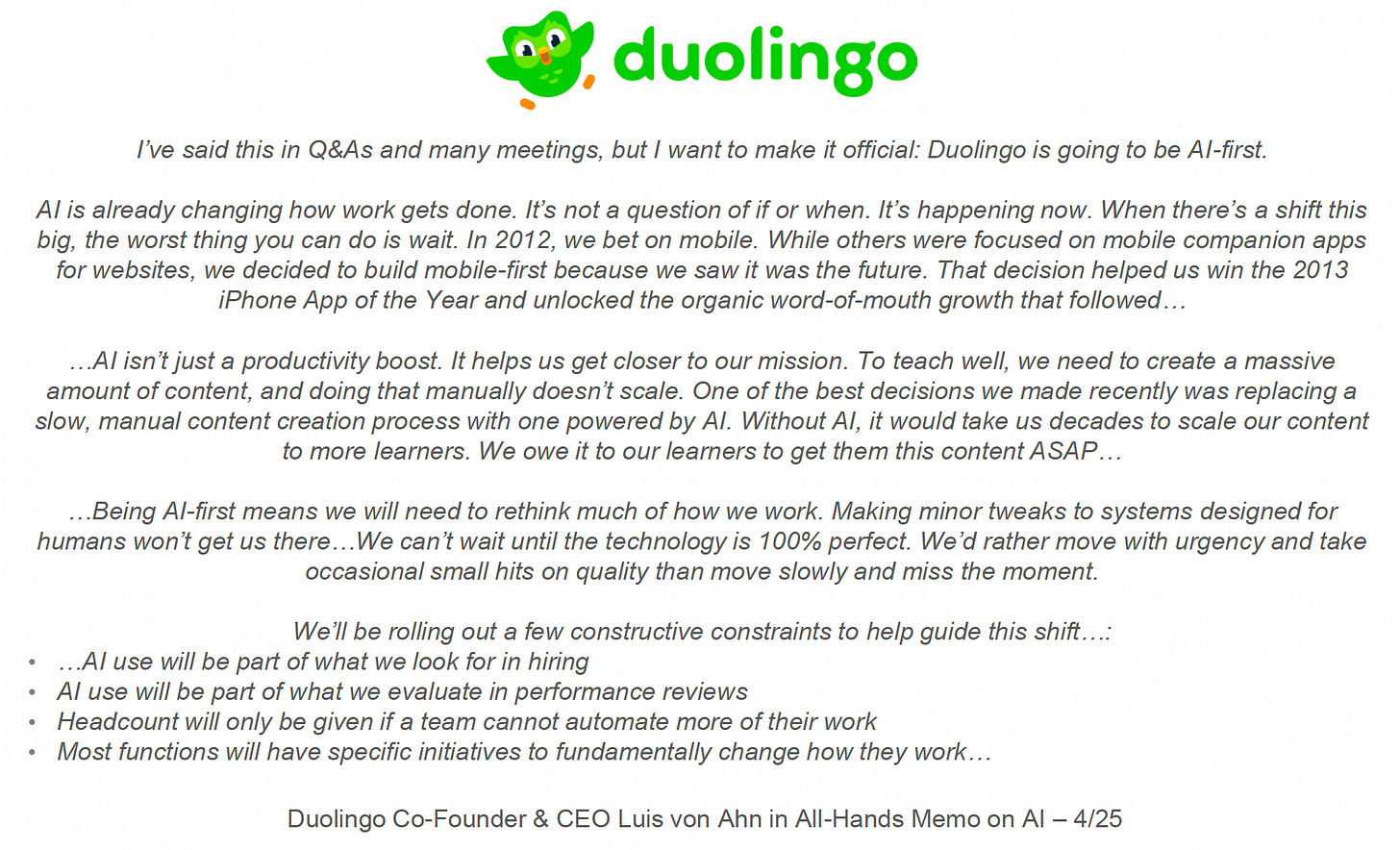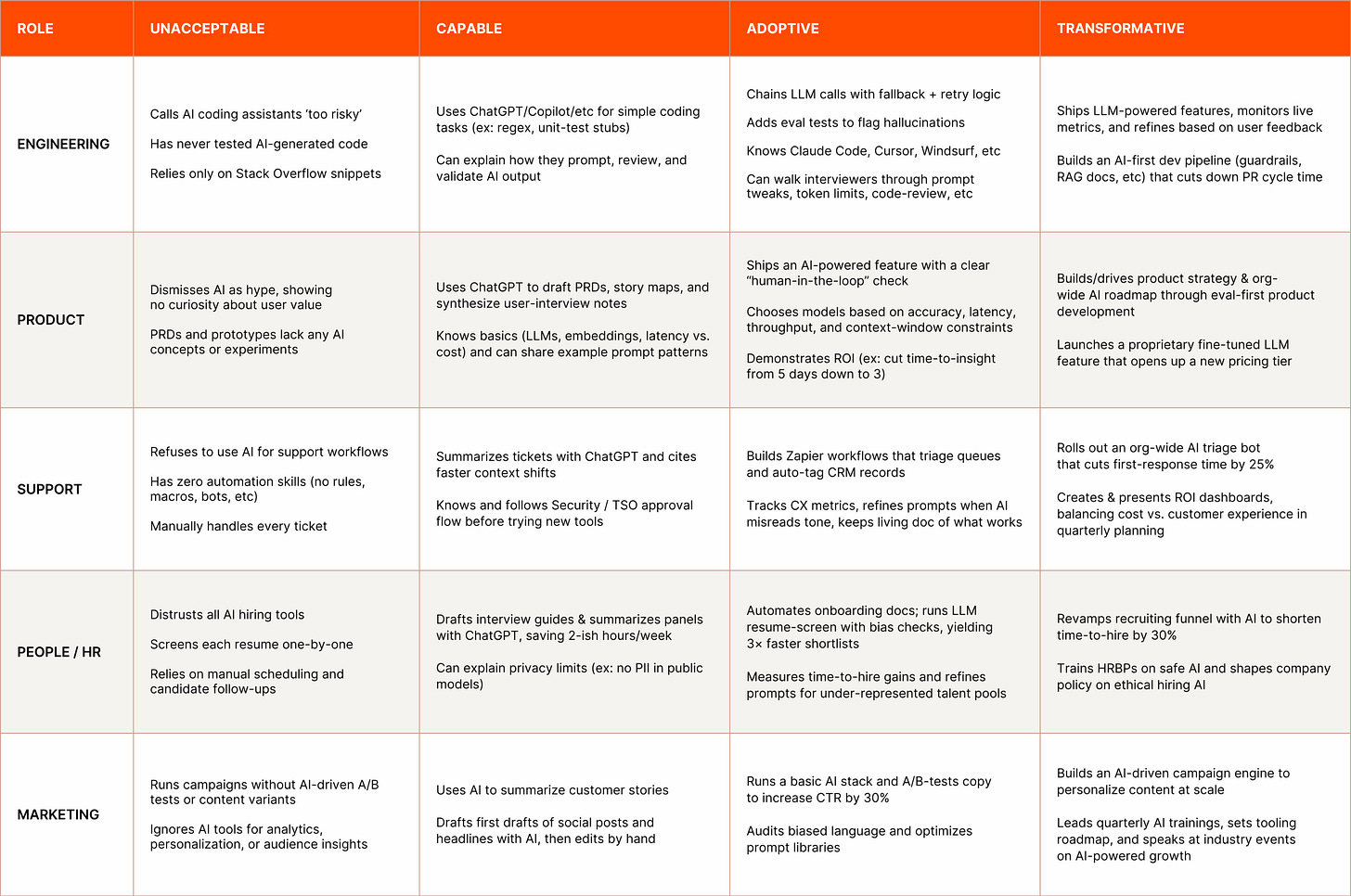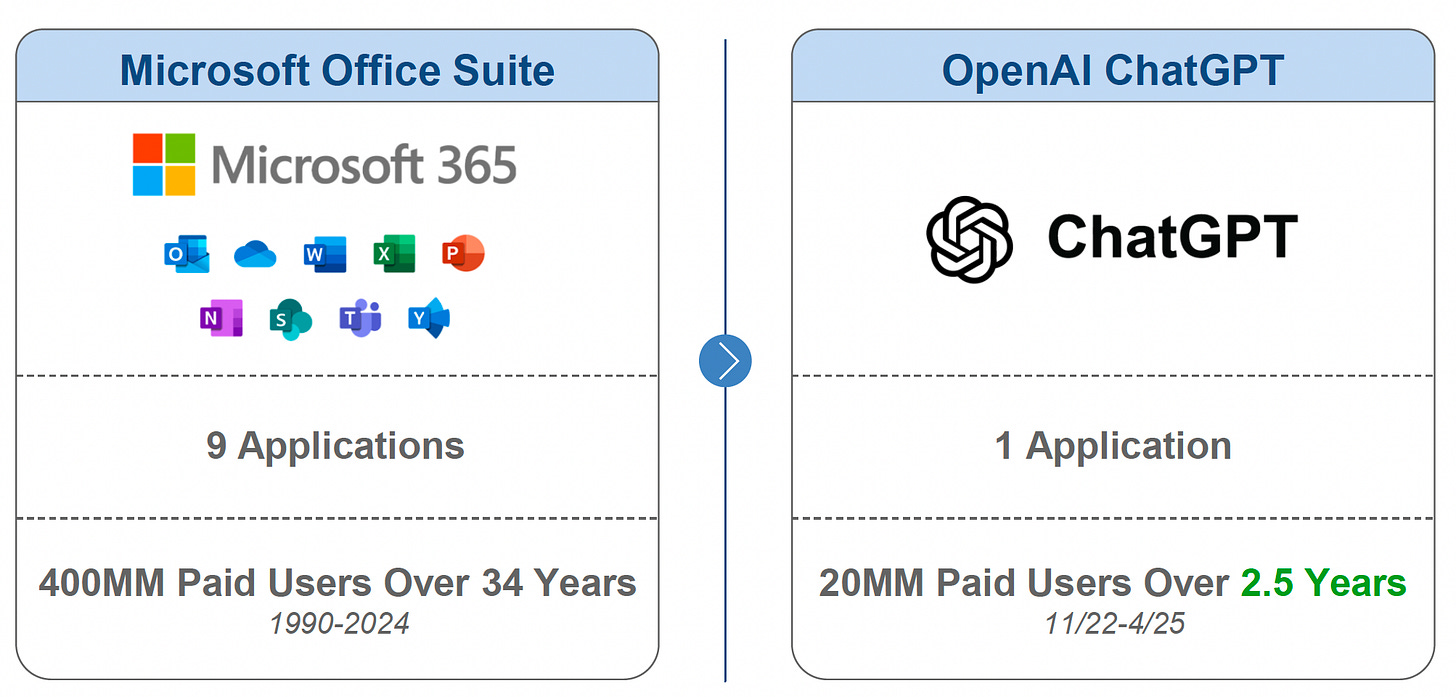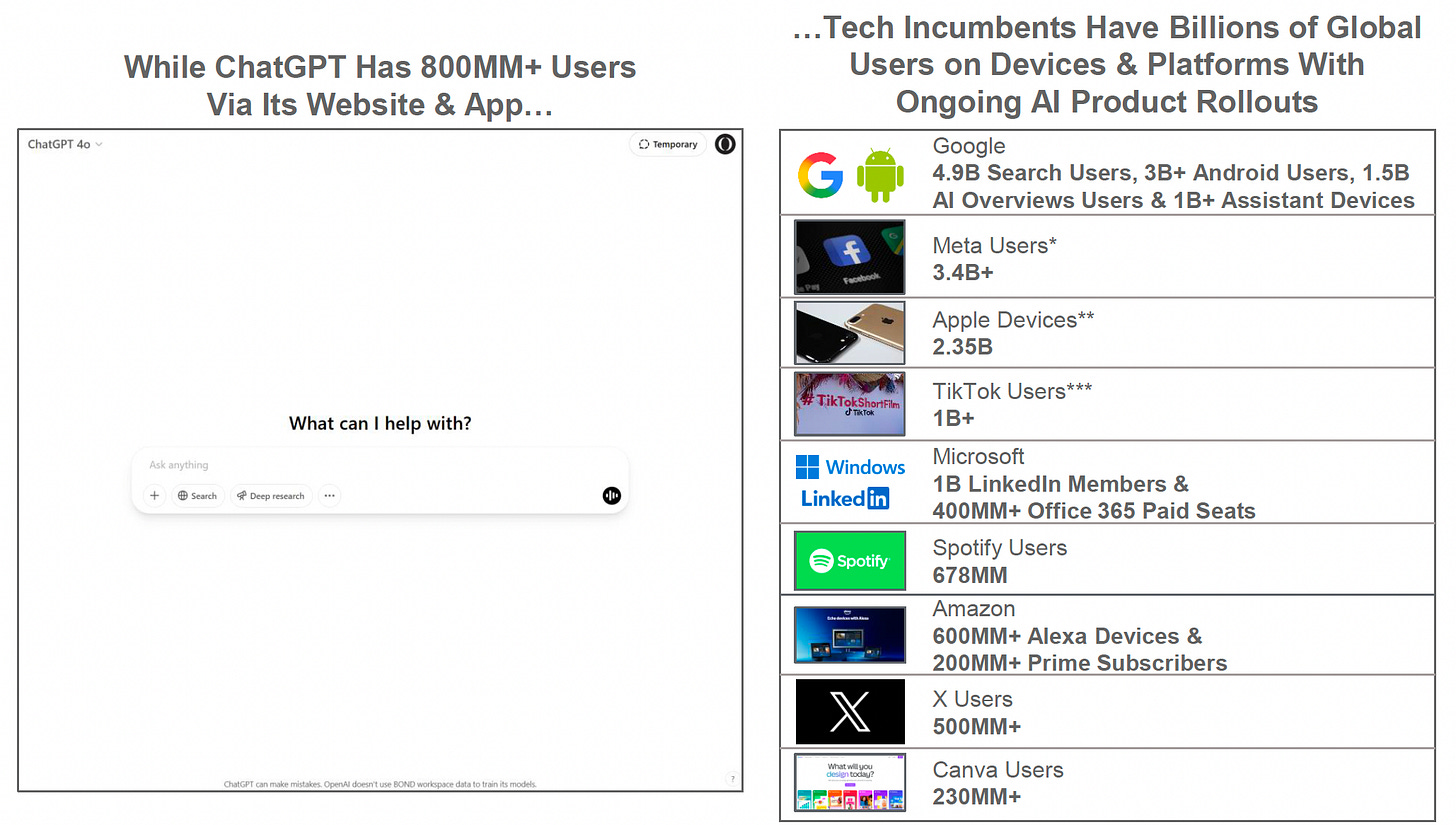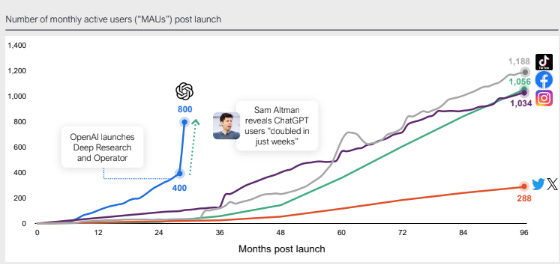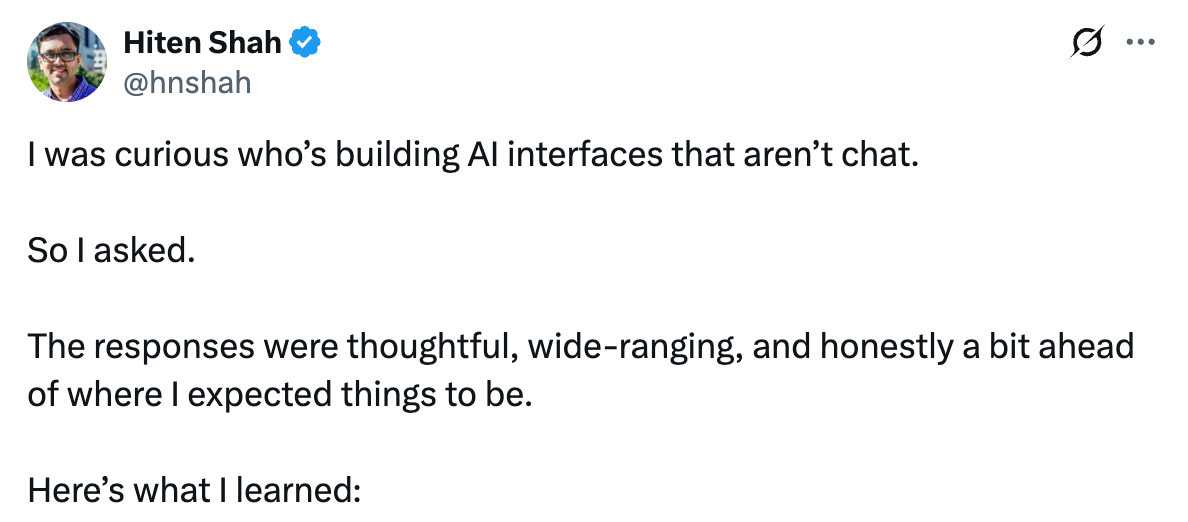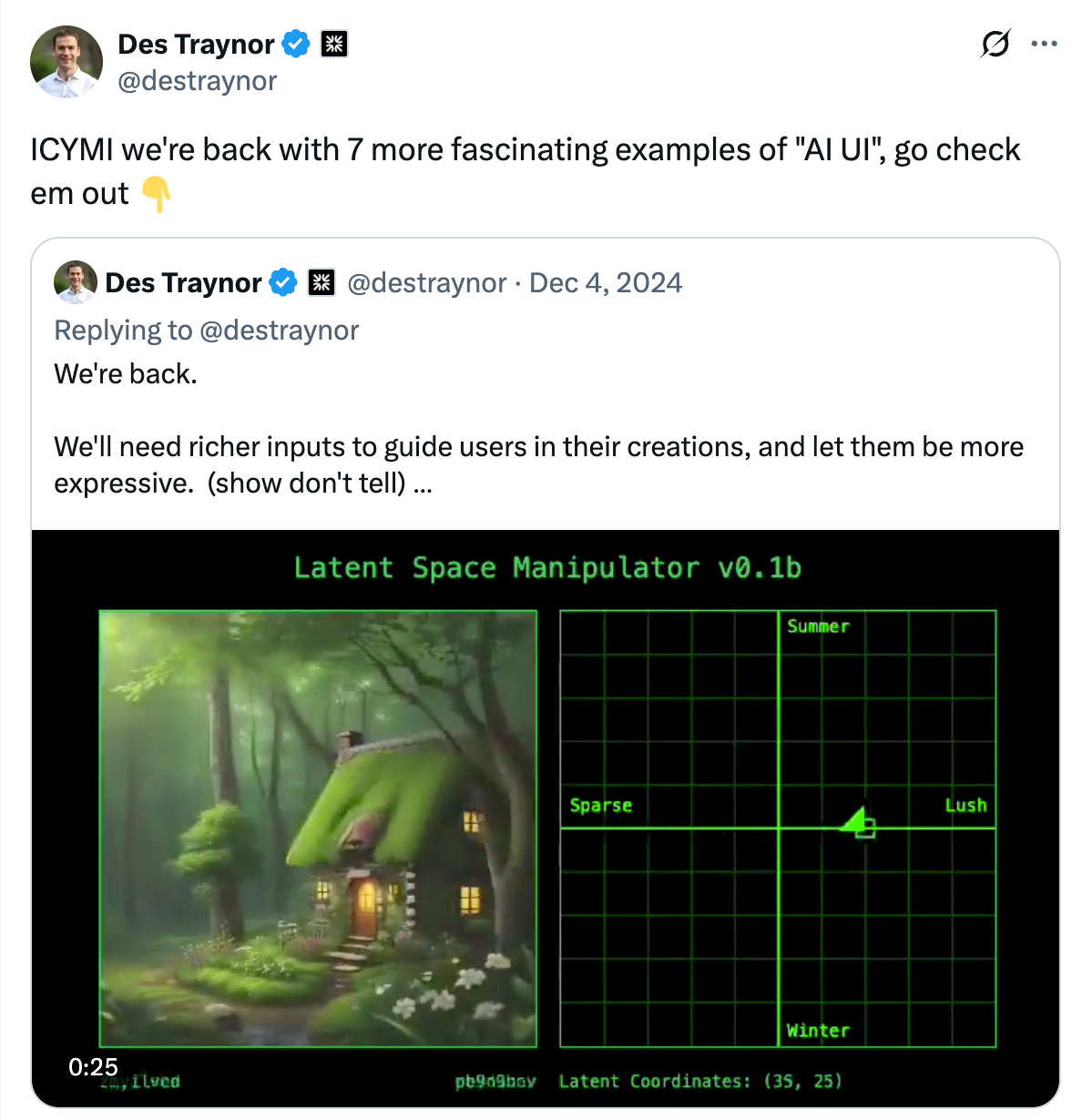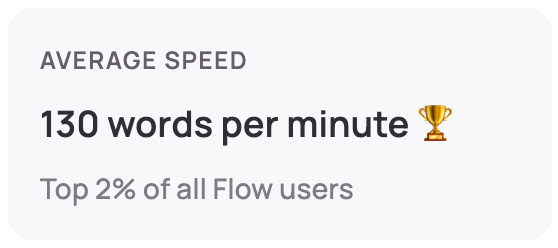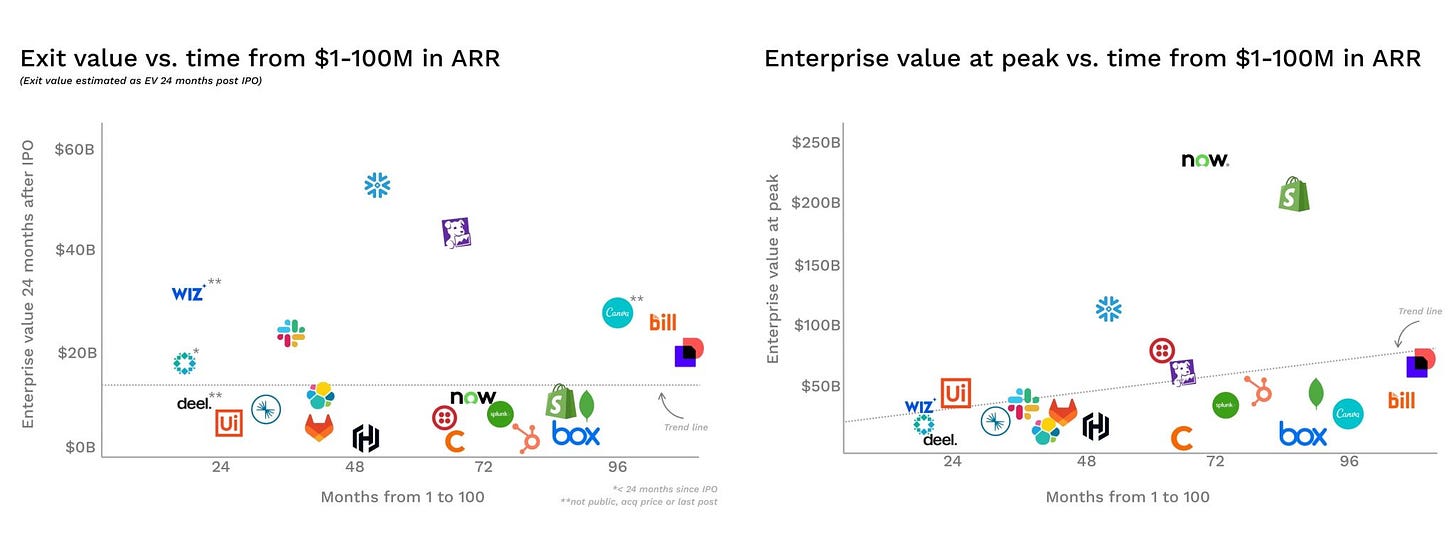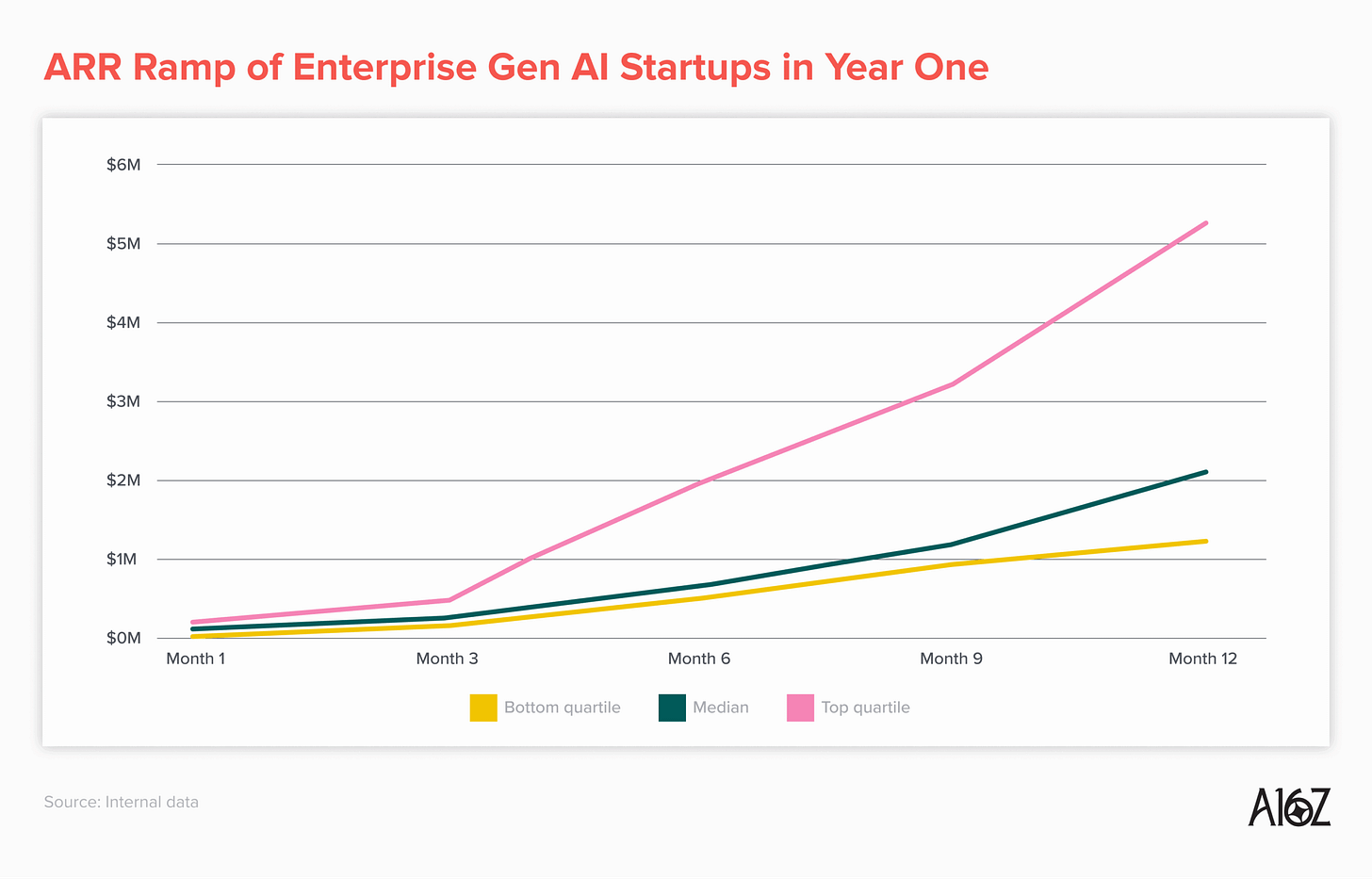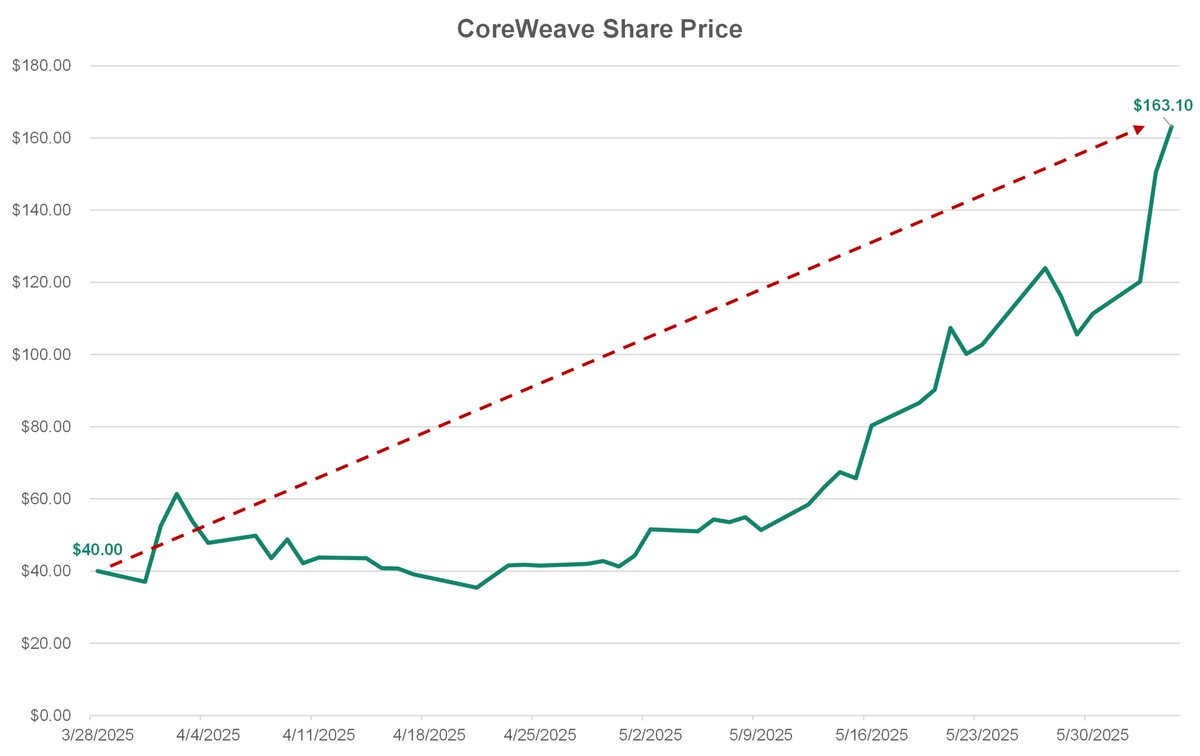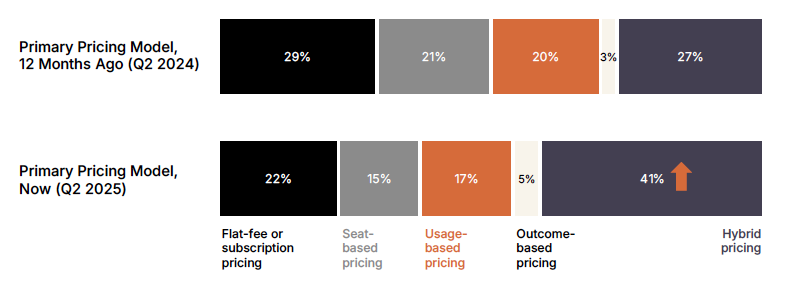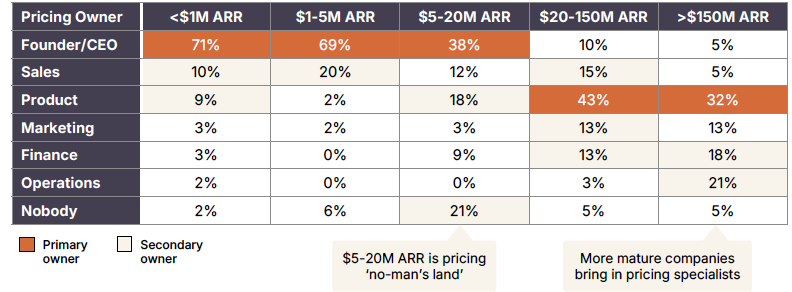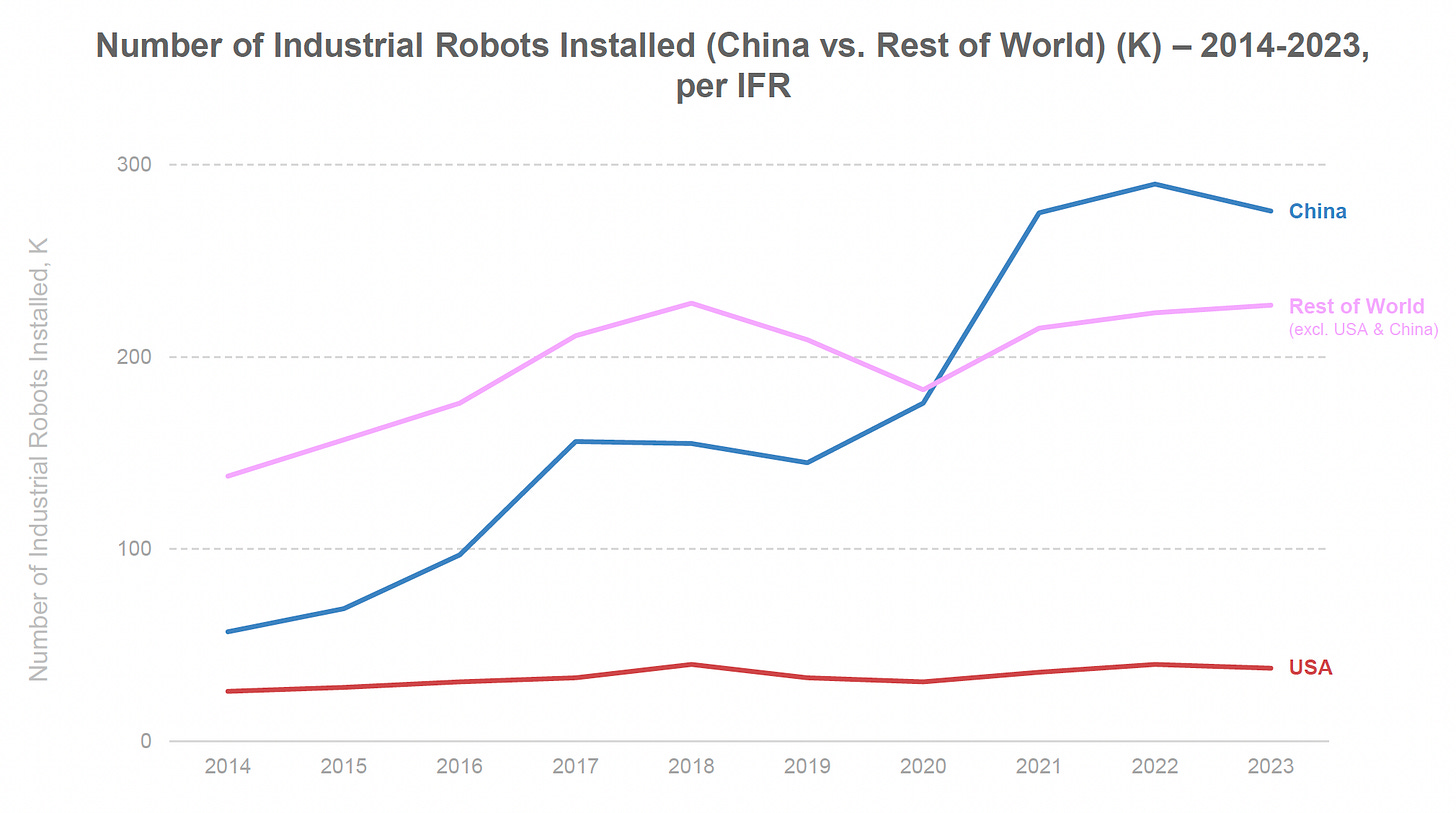What Is An AI-Native Company?
A combination of Product, Talent, Taste, and Learning Rate
Software Synthesis analyses the evolution of software companies in the age of AI - from how they're built and scaled, to how they go to market and create enduring value. You can reach me at akash@earlybird.com.
This week I’ll be hosting Luke Miller (Head of Europe for Baseten, first sales hire at Vercel) in our office for a session on 0 → 1 GTM, covering Forward Deployed Engineers, GTM Engineering, PLG → Enterprise and more. Sign up here, there are limited spots.
In the coming months I’ll be organising breakfasts in London around topics like MCP, Evals, AI Engineering and more. If you’d like to join, just drop me an email.
On to today’s post.
Since Shopify CEO Tobias Lütke released an internal memo outlining how ‘reflexive AI usage is now a baseline expectation at Shopify’ back in March, more public company CEOs have come out with similar messages of AI usage expectations.
Zapier CEO Wade Foster went one step further and released a framework for how to measure AI fluency.
These are all timely reminders to internalise just how fast the rate of change is. Having finally finished Mary Meeker’s AI Trends Report, the following lines capture this well:
Vint Cerf, one of the ‘Founders of the Internet,’ said in 1999, ‘…they say a year in the Internet business is like a dog year–equivalent to seven years in a regular person's life.’ At the time, the pace of change catalyzed by the internet was unprecedented.
Consider now that AI user and usage trending is ramping materially faster…and the machines can outpace us.
The pace and scope of change related to the artificial intelligence technology evolution is indeed unprecedented, as supported by the data.
Investors often ask whether startups can get distribution before incumbents get innovation - the below charts put into perspective how AI represents a window like no other.
Breakout AI companies are blitzing all kinds of ARR records without spending a dollar on sales and marketing.
With the stakes being so high, everyone is trying to become as AI-native as possible.
But what does that mean exactly?
Products can be built with AI infused into the entire product surface area, e.g. AI-native IDEs like Cursor, rather than retrofitting AI onto existing form factors.
Talent (technical and non-technical) can meet a minimum AI fluency baseline to ensure everyone can develop software and remove bottlenecks to growth.
Culturally, companies can foster taste through thousands of intentional decisions. Culture can also dictate a company’s learning rate - how adaptive a company is to the constant flux in the AI landscape.
Product
Cursor CEO Michael Truell recently spoke to Ben Thompson about Cursor’s origins and how they moved into developing an AI-native IDE when everyone had anointed Github Copilot as the natural market winner.
BT: GitHub was fundamentally, when they acquired it and as they developed VS code, it doesn’t have to work with Azure, but ideally from Microsoft perspective it leads to that. It’s like the Microsoft of old — they were a development company all along, but their goal was to drive Windows.
The challenge is that means that VS Code is a complement for Microsoft, it’s fundamentally unsuited to be a point of integration, because it’s meant to be a standalone modular piece, and so that’s why GitHub was only ever a plugin. Whereas you, by starting as an integrated product, it’s so deeply infused. You’re just starting from a place that Microsoft, based on their corporate goals and the reason why GitHub was acquired in the first place and why VS Code was built, they’re structurally limited from doing what you did. I don’t think people at Microsoft are dumb, I just think the problem with a large company is you’re on a set of train tracks and you actually need to be a startup to start somewhere else and that’s where you guys started.
MT: I think a couple of other things that were naturally tricky for them to contend with, not because of them but just because of what the physics of the situation are, they started with tens of millions of people using VS Code, and so there was always this tension between do we make, just for all those people, AI is kind of the first class, first party thing, or do we make it something where you have to go and install the thing?
All your customers self-select into, you know what you’re getting, you’re getting an AI code editor.
MT: That means a lot of features that are default on and changing your normal experience. They had the classic Innovator’s Dilemma problem there.
Building an AI-native product comes down to opinionated UI/design (front-end) and infrastructure (back-end) decisions.
With respect to UI/design, I’m seeing a few patterns. Firstly, early stage AI companies are hiring founding designers (and designers generally) earlier than previous cohorts of software companies.
Secondly, there’s more attention being paid to AI-native form factors, beyond chat.
When it comes to infrastructure, companies are investing more in data infrastructure to improve context retrieval for RAG, scale data ingestion for public and internal data, perform continuous fine-tuning and RLHF, format data for easier downstream consumption (e.g. knowledge graphs), and a whole host of other things. Ultimately, these decisions are being made with agents being the first class actor in mind.
It’s still early days on both dimensions of product, with plenty of new ground to break.
Talent
Sarah Tavel recently interviewed Borislav Nikolov, CTO of Rekki, on how he instituted AI competence across his team:
Previously what was always missing and why the low code and no code solution would fall flat was because at some point, it's just not expressive enough. Somebody has to write the code. There is this law of irreducible complexity. But he realized that if he could give his team the right infrastructure for their code to run somewhere safely, with things like privacy considerations, security, and notifications if there is a problem, he could empower everyone in the company to code and solve their own problems.
Rather than divide the company into developers and non-developers, if everyone could write SQL, Borislav realized that the jump to building automations on a service like Zapier or Make.com was finally possible.
Depending on the company, the primitives will be different. But to Borislav, “the important part is to think of the whole company as people who can truly build anything they put their mind to, and the only limit is you, your attitude, and your infrastructure.”
Borislav made the whole team watch videos to understand how deep learning works and forced non-technical domain experts to try using Cursor and other tools instead of adding more to the engineering team’s backlog.
AI-native companies will aspire for similar levels of proficiency in AI as it’ll increase your throughput as an organisation - this is ultimately what’s driving the ‘lean AI native’ leaderboards of companies decimating prior benchmarks of ARR per FTE.
As more companies share their frameworks for assessing AI fluency, benchmarking talent will become more rigorous and data-driven.
AI startups are making it easier for you to showcase your proficiency - I expect stats like the one below from my Wispr Flow usage to become commonplace. Some founders are already explicitly looking for top percentile users of the very best AI tools.
Culture: Taste and Learning Rate
As traditional software moats erode, Peter Drucker’s aphorism rings truer than ever:
‘Culture eats strategy for breakfast’
Equally, as AI-native coding tools raise the ceiling and lower the floor for programming, taste, as a component of culture, is becoming more important.
I think taste will be increasingly more valuable... more and more, being an engineer will start to feel like being a logic designer, and really, it will be about specifying your intent for how exactly you want everything to work. It'd be more about the whats, and a little bit less about how exactly you're going to do things under the hood.
If you get rid of the human compilation steps where you have to really carefully spell out what you want to the computer, and if you can actually succeed in just making software, where building is about specifying what you want, then I think what’s left is the taste for defining useful and good things that you want to show up on the screen, and useful and good logic for how the software should work.
Michael Truell, Cursor CEO, on Lenny’s podcast and Ben Thompson
Sarah Guo published an excellent essay (genuinely worth reading in full) on how taste manifests inside a company - some standout parts:
This is taste. The relentless, almost painful ability to know what should exist, what shouldn't, and where quality matters. It's the difference between shipping a product and shipping a point of view.
The best founders understand that taste is a competitive advantage that compounds. It runs deeper than pixels—it's in your codebase, your culture, your cap table.
Real taste hurts. It's saying no to features that would triple your TAM. It's spending a week perfecting an interaction that users will barely notice—consciously. It's choosing the harder technical path because the UX is 10% better. If your "taste" doesn't cost you something, it's not taste. It's preference.
When you know exactly what you're building and why, you waste less time on revisions, pivots, and apology releases. Clear taste acts as a decision-making accelerant. Every choice becomes obvious when filtered through a coherent point of view.
This clarity cascades through everything. When software feels intentional, users assume the infrastructure, security, and roadmap are too. Your product gets judged in seconds, your website in one. That first impression becomes a permission structure for everything else.
Taste enforces one voice everywhere: landing page, sales deck, support docs. Customers feel they're dealing with a singular intelligence, not a committee.
You need people who see selling as a craft worth perfecting—who agonize over email copy the way your engineers obsess over code. Who understand your vision deeply enough to turn away wrong-fit customers. Who have enough empathy for users to protect them from bad purchases.
Here's what most founders miss: your sales team's Zoom background matters. How they share their screen matters. Whether they fumble through tabs or flow through a story matters. Prospects pattern-match constantly—if your sales process feels generic, they'll assume your product is too.
Taste doesn't scale by accident. It scales through systems. Start with the founder edit. Early on, every user-facing decision flows through one person—not for control, but for consistency. This only works with respect, explanation, and velocity. You're not a bottleneck; you're a tuning fork.
In a world where AI can instantly generate a CRUD app or replicate any website, taste becomes the final differentiator. Features can be copied. Functionality can be matched. But the feeling of using something crafted with intention? That's irreplaceable.
People have been writing about taste for a while in the wake of AI, but few have been able to put their finger on exactly what good taste looks like - this essay is the best one yet, to the extent it can be learned. To me, the single sentence that captures how taste is an intrinsic part of culture is:
Taste resists commoditization because it's not a feature—it's a philosophy encoded in ten thousand decisions.
The other aspect of culture that’s key is a company’s learning rate. Some of the very best founders are often described as ‘learning machines’, a trait that they’re able to infuse into their entire company:
When I speak to new entrepreneurs, I say to them when they're talking about their idea, most of them start out not wanting to share their idea, because they feel like their idea is the most unique idea in the world. And you then start saying, "Well, the truth of the matter is the idea isn't that important." The second thing they try to do is, even as they're sharing it, they're trying to get me to critique their idea.
And what I should have realized in all of those examples is that there were highly unique people that were learning machines and incredibly driven, that were behind all of these businesses.
Every single insight that we have is a depreciating insight. It is a very, very depreciating insight. The reason why companies win at any given point is not because they had an insight like one year ago, right? Actually, if a company wins, other than the fact that they have, you know, a monopoly, it's actually a compounding tech advantage that keeps sort of existing over and over again.
I also think for us and I tell the company this, if we're not continuing to have insights (and that's why I'm completely okay with a lot of our insights being wrong), if we don't continually have insights that we are executing on, we are just slowly dying.
The best founders and companies continuously iterate and change their priors. The very best AI-native companies have no priors and see that as a competitive advantage in a technology landscape as fast-moving as the current AI landscape.
These companies are truth-seeking and constantly revise their assumptions. Much like CI/CE has become core to a startup’s evals pipeline, the velocity of learning and changing your weights and biases (pun intended) is as telling an indicator of a startup’s probability of success as any other.
Further reading
Countless smart founders and investors have been obsessing about how to think about building AI-native companies:
The Unsung Ingredient in Stripe, Square and Linear’s Success: Taste
Taste Is Eating Silicon Valley
AI-native founders and the new reality for early stage investing
Data
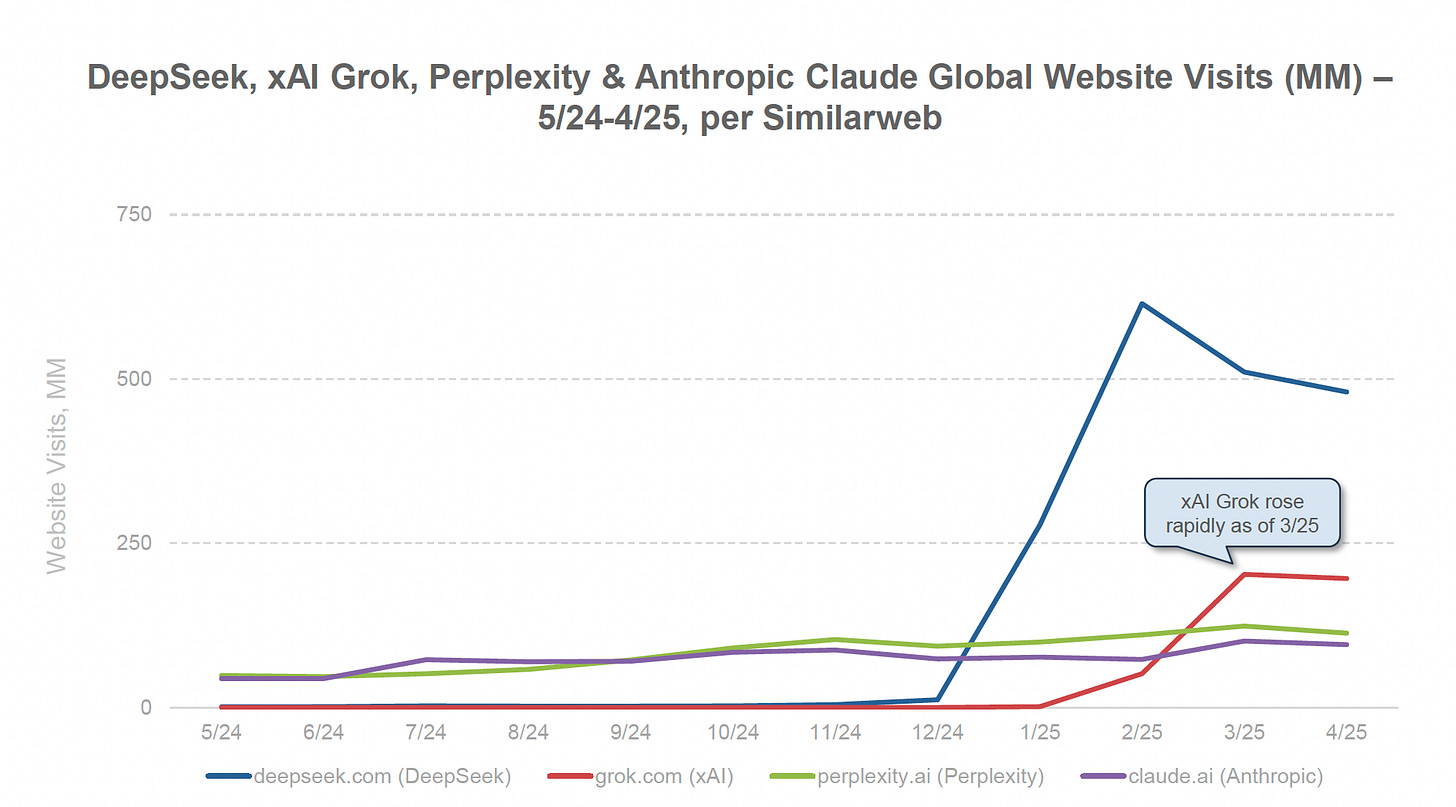
Jobs
Companies in my network are actively looking for talent - if any roles sound like a fit for you or your friends, don’t hesitate to reach out to me.
If you’re exploring starting your own company or joining one, or just figuring out what’s next, reach out to me - I’d love to introduce you to some of the excellent talent in my network.
Longform reads
Agent Experience Is the Only Experience That Matters
The state of B2B monetization in 2025
Nvidia Earnings, Nvidia’s China Argument, NVLink Fusion
Ensuring accurate product attributes at the source
SQL vs NoSQL: Choosing the Right Database for An Application
Have any feedback? Email me at akash@earlybird.com.



